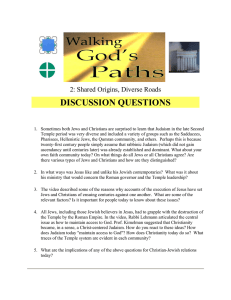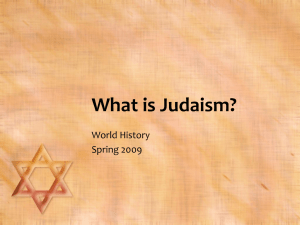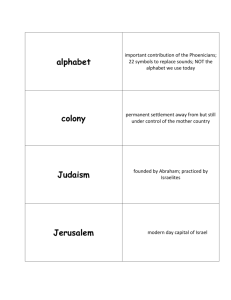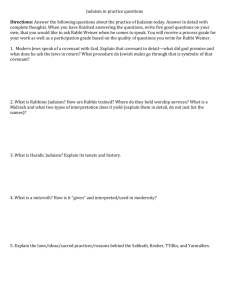SCRIPT 5. Metaphors for a Unique Relationship
advertisement
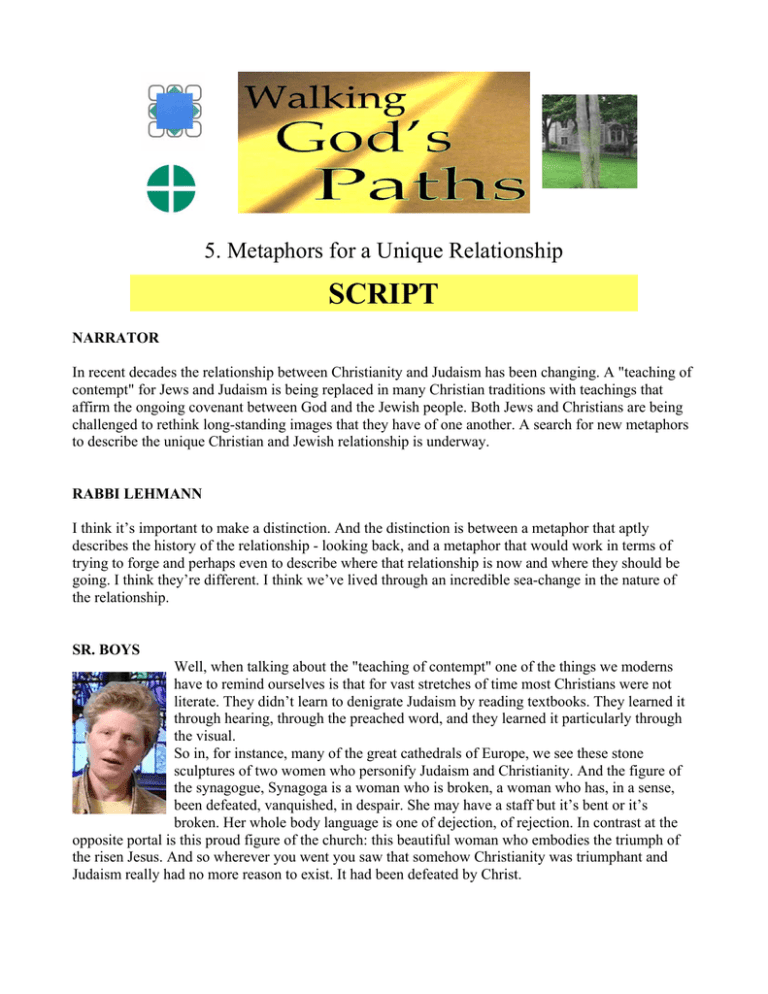
5. Metaphors for a Unique Relationship SCRIPT NARRATOR In recent decades the relationship between Christianity and Judaism has been changing. A "teaching of contempt" for Jews and Judaism is being replaced in many Christian traditions with teachings that affirm the ongoing covenant between God and the Jewish people. Both Jews and Christians are being challenged to rethink long-standing images that they have of one another. A search for new metaphors to describe the unique Christian and Jewish relationship is underway. RABBI LEHMANN I think it’s important to make a distinction. And the distinction is between a metaphor that aptly describes the history of the relationship - looking back, and a metaphor that would work in terms of trying to forge and perhaps even to describe where that relationship is now and where they should be going. I think they’re different. I think we’ve lived through an incredible sea-change in the nature of the relationship. SR. BOYS Well, when talking about the "teaching of contempt" one of the things we moderns have to remind ourselves is that for vast stretches of time most Christians were not literate. They didn’t learn to denigrate Judaism by reading textbooks. They learned it through hearing, through the preached word, and they learned it particularly through the visual. So in, for instance, many of the great cathedrals of Europe, we see these stone sculptures of two women who personify Judaism and Christianity. And the figure of the synagogue, Synagoga is a woman who is broken, a woman who has, in a sense, been defeated, vanquished, in despair. She may have a staff but it’s bent or it’s broken. Her whole body language is one of dejection, of rejection. In contrast at the opposite portal is this proud figure of the church: this beautiful woman who embodies the triumph of the risen Jesus. And so wherever you went you saw that somehow Christianity was triumphant and Judaism really had no more reason to exist. It had been defeated by Christ. PROF. LEVINE When I look at the sculptures of Synagoga and Ecclesia what particularly strikes me is that the image for the synagogue has a blindfold on. She’s blind, as if the Jews never really had the truth, they could never see. That particular image delegitimates any Jewish interpretation not only following the time of Jesus but any Jewish understanding of the Old Testament, the Tanakh. I think today Christians recognized that, in fact, they are the ones who have had the blinders on; that they have been unable to appreciate that vibrant Jewish tradition. Today thank God everybody’s blindfold is off. SR. BOYS So when I was writing some of this history about Synagoga and Ecclesia, I got this inspiration: well I need to show not only what it was but how today could Synagoga and Ecclesia be brought back to personify the relationship we are working so hard to develop. I commissioned an artist, Paula Mary Turnbull of Spokane, Washington, a long time friend and a well-known sculptor in the Northwest, and a member of my community, to do a new Synagoga and Ecclesia. One of the things I think is very moving about this is to see the strength of this sculpture in copper and bronze and this woman as independent as is Ecclesia. They’re movable so they can be shown sort of in proximity to one another. And I think that we need to develop new images. This does not exhaust the imagery. NARRATOR The search for new metaphors continues. Different voices offer different suggestions depending on which aspect of the Jewish and Christian relationship they choose to emphasize. As with all symbols, metaphors suggest how an image resembles the item under discussion, but at the same time they are only partial expressions of reality. It is especially difficult to visualize something as complex and multi-dimensional as the relationship between Christianity and Judaism. RABBI ROSENTHAL I know that John Paul II likes the metaphor of elder brother/ younger brother, which I think, if I’m not mistaken, John XXIII was the first to suggest, when he said, "I am Joseph your brother", a very touching, beautiful moment, as he greeted a Jewish delegation - an unforgettable moment. Perhaps that set the whole mood, as they say, for Vatican II and subsequent developments, the wonderful, hopeful developments. I’ve always, personally, I’ve always liked the image of Judaism as the Mother religion and Christianity as the Daughter religion. FR. SMIGA When I searched for a metaphor for myself in terms of helping us understand Jewish/Christian relations, seeing that my background is scripture, I tend to turn to a scriptural metaphor, and we have a rather powerful one in Paul’s letter to the Romans. Paul addresses the non-Jewish members of the Roman community, and he reminds them that they who are in Christ are like wild shoots that have been grafted on to a domesticated and fruitful olive plant, olive tree. The tree, the olive tree, being the Jewish tradition and a reminder, on Paul’s part, that the non-Jews should in no way feel superior simply because they have Christ, because their ability to have Christ is simply because it has been grafted on to an earlier and much more productive root. "Whenever we’re feeling that we have a superiority," Paul says, "Remember, to us non-Jewish believers in Christ: It is not you that support the root, it is the root that supports you." RABBI LEHMANN So, I would like to suggest a new metaphor, at least something to get us thinking in a different direction. That is the metaphor of what in Aramaic we call a chevrutah, that is a learning partner. A learning partner is someone with whom you study texts, biblical or other kinds of traditional texts, but you study it in order to have a dialogue, an interlocutor, with whom truth can emerge as you play out your different perspectives on the texts. And, it’s a kind of relationship which is very intimate, in which there is a sense of shared texts, and even a covenantal relationship, but in which the partners are not just trying to agree, but in fact, trying to see how their different perspectives can enhance the other person’s understanding. Again, I would like to shift from dialogue to learning. I think it’s really about sharing insights and interpretations in the common texts that we share. PROF. KIMELMAN And it would seem to me, I can’t imagine two religions committed to a one God who believe that humanity was created in the image of God, would not want to invest their most significant intellectual efforts in looking for images of reconciliation than images of hostility. Now elder/younger brother is one which is very popular, and it may be a very helpful relationship. The phrase, First and Second Testament, is another way of talking about it. Another way of saying it, First and Second Blessing, may even be better because the word "testament" having a legal sense could make you believe that the second replaces the first no matter what, even if there is a third and fourth. I never heard of the phrase Second Blessing replacing the phrase First Blessing. Second Blessing means there is an additional blessing. PROF. LEE But what I think my image of this is that biblical Judaism -- prior to the destruction of the second temple -- represents a foundation from which two branches emerge. And each is responding to the changing circumstances in which they find themselves and to some degree to each other; namely Rabbinic Judaism and early Christianity. [They] then sort of merge out, but since they are rooted in a common foundation I think the best way to talk about it is it’s a sibling relationship, but it has been a highly problematic sibling relationship. SR. BOYS An image of Judaism and Christianity that is around today that I find very suggestive is partners in waiting for the full redemption of the world. We may differ, Jews and Christians, about the redemption that we Christians see Jesus has brought, but clearly full redemption still eludes us. And so, with Jews we stand in this active posture of waiting and we stand with them in partnership working to heal the world. I think that’s a very moving image. RABBI ROSENTHAL Cardinal Walter Kasper’s been saying lately that "No one metaphor properly encapsulates the very complex relationship." I think he’s right. PROF. LEE If we’re looking for what we are trying to achieve at this point, it is the reconciliation, really, and the rapprochement of these two siblings who have had a very difficult, alienated, problematic relationship over the centuries. NARRATOR Mother and daughter, siblings, branches from a common root, First and Second Blessing, study partners, partners-in-waiting: each of these metaphors seeks to capture the complexities of the Jewish and Christian relationship. If no single one of them fully expresses this relationship, perhaps their various insights will help Christians and Jews as they seek to build a new future together. RABBI ROSENTHAL There is a responsibility for both of us to work together. I like the way John Paul II put it. He wants us both, Jews and Christians, to be "a blessing to the world." He, in effect, is paraphrasing God’s commandment in Genesis to Abraham, "You shall be blessed, and all the nations of the world will be blessed through you." That is the great imperative given to Jews and Christians in partnership, in tandem, if you will. Yes, I do believe that. I believe that we Jews and we Christians have that great Commandment to be a blessing to humanity.
